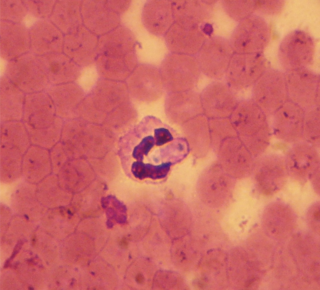Related Research Articles

Plasmodium is a genus of unicellular eukaryotes that are obligate parasites of vertebrates and insects. The life cycles of Plasmodium species involve development in a blood-feeding insect host which then injects parasites into a vertebrate host during a blood meal. Parasites grow within a vertebrate body tissue before entering the bloodstream to infect red blood cells. The ensuing destruction of host red blood cells can result in disease, called malaria. During this infection, some parasites are picked up by a blood-feeding insect, continuing the life cycle.

Trematoda is a class within the phylum Platyhelminthes. It includes two groups of parasitic flatworms, known as flukes.

Monogeneans are a group of ectoparasitic flatworms commonly found on the skin, gills, or fins of fish. They have a direct lifecycle and do not require an intermediate host. Adults are hermaphrodites, meaning they have both male and female reproductive structures.

Anisakis is a genus of parasitic nematodes that have life cycles involving fish and marine mammals. They are infective to humans and cause anisakiasis. People who produce immunoglobulin E in response to this parasite may subsequently have an allergic reaction, including anaphylaxis, after eating fish infected with Anisakis species.

Hepatozoon is a genus of Apicomplexa alveolates which incorporates over 300 species obligate intraerythrocytic parasites. Species have been described from all groups of tetrapod vertebrates, as well as a wide range of haematophagous arthropods, which serve as both the vectors and definitive hosts of the parasite. By far the most biodiverse and prevalent of all haemogregarines, the genus is distinguished by its unique reciprocal trophic lifecycle which lacks the salivary transmission between hosts commonly associated with other apicomplexans. While particularly prevalent in amphibians and reptiles, the genus is more well known in veterinary circles for causing a tick-borne disease called hepatozoonosis in some mammals.
Isospora is a genus of internal parasites in the subclass Coccidia.

Adeleorina is a suborder of parasites in the phylum Apicomplexa.
Amoebophyra is a genus of dinoflagellates. Amoebophyra is a syndinian parasite that infects free-living dinoflagellates that are attributed to a single species by using several host-specific parasites. It acts as "biological control agents for red tides and in defining species of Amoebophrya." Researchers have found a correlation between a large amount of host specify and the impact host parasites may have on other organisms. Due to the host specificity found in each strain of Amoebophrya's physical makeup, further studies need to be tested to determine whether the Amoebophrya can act as a control against harmful algal blooms.
Garnia is a genus of parasitic alveolates belonging to the phylum Apicomplexia.
Frenkelia is a genus of parasites in the phylum Apicomplexa. The species in this genus infect the gastrointestinal tracts of birds of prey and the tissues of small rodents.
Legerella is a genus of parasitic alveolates of the phylum Apicomplexa. Species in this genus that usually infect the malpighian tubules of invertebrates.
Cardiosporidium is a genus of parasitic alveolates in the phylum Apicomplexa. It infects the ascidian Ciona intestinalis.
Pseudoklossia is a genus in the phylum Apicomplexa. Species in this genus infect marine molluscs, although one species infects in an ascidian worm. The life cycle is heteroxenous.
Selenidioides are a genus of parasitic alveolates in the phylum Apicomplexa. Species in this genus infect marine invertebrates.
Veloxidium is a genus of parasitic alveolates in the phylum Apicomplexa. Species in this genus infect marine invertebrates.
The Platyproteum are a genus of parasitic alveolates in the phylum Apicomplexa. Species in this genus infect marine invertebrates.
Filipodium is a genus of parasites in the phylum Apicomplexa. Species in this genus infect marine invertebrates.
Lipotropha is a genus of parasitic alveolates of the phylum Apicomplexa.
Lipocystis is a genus of parasitic alveolates of the phylum Apicomplexa.
Siedleckiidae is a family of parasitic alveolates in the phylum Apicomplexa. Species in this family infect marine invertebrates.
References
- ↑ Diakin A, Simdyanov TG, Paskerova G, Alesohin VV, Entzeroth R, Schrevel J, Valigurova A (2012) Phylogenetic study on early emerging apicomplexans with emphasis on genera Eleutheroschizon and Siedleckia. In: X. české a slovenské parazitologické dny. ISBN 978-80-210-5862-0
| | This Apicomplexa-related article is a stub. You can help Wikipedia by expanding it. |